Explore Phang Nga - Thailand Travel, Asia
Nestled in southern Thailand, Phang Nga is a hidden gem of Thailand that offers a captivating blend of natural beauty and cultural richness. The region’s pristine landscapes, including the famous Phang Nga Bay with its towering karst formations, make it a must-visit destination. With its clear turquoise waters, lush jungles, and charming villages, Phang Nga invites visitors to explore its diverse attractions. Whether you're an adventure seeker, a nature lover, or someone looking to immerse yourself in local culture, Phang Nga promises a memorable experience, from exploring hidden caves to indulging in local cuisine.
Population: Approximately 270,000 in 2018.
Economy: Phang Nga's economy is driven by tourism, agriculture, and fishing. It thrives on attracting visitors to its natural attractions, while also benefiting from local farming and seafood industries.
Landmarks: Famous for the Phang Nga Bay, Similan Islands, and Koh Yao Islands.
Thailand
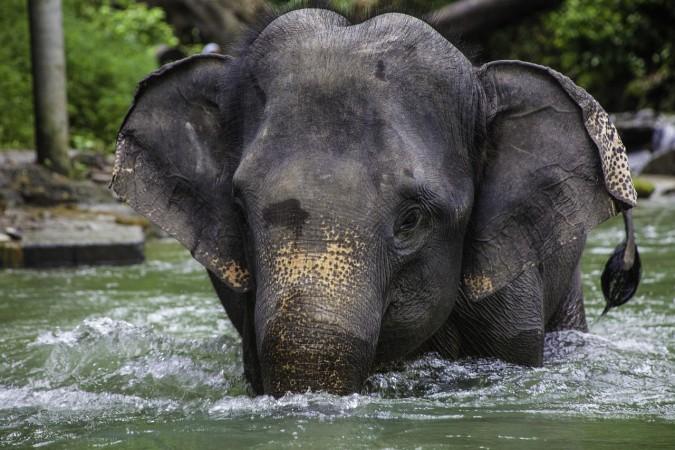
Overview of Phang Nga
History & Cultural Influence
Phang Nga’s history is as rich and varied as its landscapes. Originally settled by sea gypsies and fishing communities, the area has seen influences from various cultures over the centuries. One of the most significant historical sites in Phang Nga is the Wat Tham Suwan Khuha, a Buddhist temple located in a cave. This site, also known as the “Cave Temple,” is a testament to the region’s spiritual heritage and provides a glimpse into traditional Thai Buddhist practices. Furthermore, Phang Nga’s cultural tapestry is deeply enriched by its local festivals and traditions, which reflect a blend of indigenous beliefs and external influences.
Interaction with the Locals
Phang Nga, a province in southern Thailand, has a population of approximately 270,000 residents. The local population includes a mix of ethnic Thais and minority groups, such as the Sea Gypsies (Chao Leh) and Chinese-Thais. The citizens of Phang Nga are known for their hospitality and traditional lifestyles, which are deeply rooted in the region's cultural heritage. The local economy is driven by tourism, fishing, and agriculture, contributing to a vibrant community that welcomes visitors with warmth and friendliness.
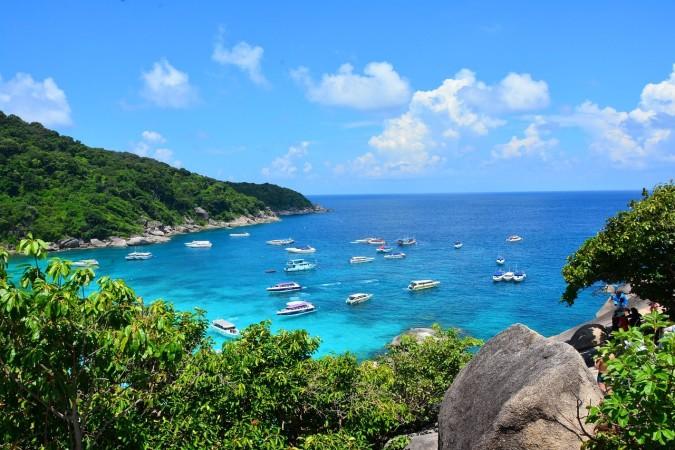
Phang Nga's natural beauty - © Vickiiz2326
Top Attractions in Phang Nga
Phang Nga Bay
Renowned for its stunning seascape, Phang Nga Bay is a must-visit destination. The bay is characterized by its dramatic limestone karsts, which rise majestically from the emerald waters. A boat tour through the bay reveals hidden lagoons and caves, including the famous James Bond Island, made famous by the movie “The Man with the Golden Gun.” Kayaking through the bay’s tranquil waters allows you to explore the bay’s natural beauty up close and appreciate its unique geological formations.
Similan Islands
Located in the Andaman Sea, the Similan Islands are celebrated as one of Thailand's premier dive sites. The islands are part of a protected national park and are well-known for their crystal-clear seas and varied marine life. Scuba divers and snorkelers can encounter vibrant coral reefs, schools of colorful fish, and even manta rays and whale sharks. The underwater landscape is as stunning as the islands themselves, making it a paradise for those seeking an unforgettable diving experience.
Koh Yao Islands
The Koh Yao Islands, which include Koh Yao Noi and Koh Yao Yai, provide a tranquil escape from the noise and bustle of more popular regions. These islands are perfect for those seeking tranquility and a glimpse into traditional Thai island life. Enjoy serene beaches with powdery white sand, explore lush jungle trails, and visit local villages where you can experience authentic island culture. The islands are also known for their beautiful sunsets and relaxed atmosphere, making them an ideal destination for a serene getaway.
Phang Nga Elephant Park
For a wonderful and ethical animal encounter, the Phang Nga Elephant Park is a fantastic choice. The park focuses on providing humane and responsible interactions with elephants. Visitors can learn about these majestic creatures through educational programs, observe their natural behaviors, and participate in feeding and bathing sessions. The park’s commitment to elephant welfare ensures a meaningful and enriching experience while promoting the conservation of these incredible animals.

Phang Nga Bay - © qimono
Must-Try Dishes in Phang Nga
Phang Nga’s culinary heritage is a delightful exploration of Thai flavors, offering a range of must-try local dishes that reflect the region's rich cultural influences.
- Massaman Curry: This rich and aromatic curry is a staple in Phang Nga, featuring tender chunks of meat cooked in a sauce of coconut milk, tamarind, and a blend of spices including cardamom and cinnamon. The result is a harmonious balance of sweet, savory, and mildly spicy flavors.
- Pad Thai: Pad Thai in Phang Nga is a famous Thai street food prepared with stir-fried rice noodles, shrimp or chicken, eggs, and a sour tamarind sauce. Garnished with peanuts, lime, and fresh herbs, it offers a satisfying mix of textures and tastes.
- Som Tum: This spicy green papaya salad is both refreshing and flavorful. It combines shredded green papaya with tomatoes, chilies, peanuts, and a tangy lime dressing. The result is a vibrant and crunchy salad that balances heat with refreshing citrus notes.
- Khao Mok Gai: Often referred to as Thai biryani, Khao Mok Gai features fragrant yellow rice cooked with chicken and a blend of spices including turmeric. It is usually served with a side of cucumber salad and a tangy dipping sauce.
- Tom Yum Goong: This iconic Thai soup is known for its bold flavors of lemongrass, kaffir lime leaves, and galangal. The soup typically includes shrimp, mushrooms, and a splash of lime juice, making it a spicy and tangy treat.
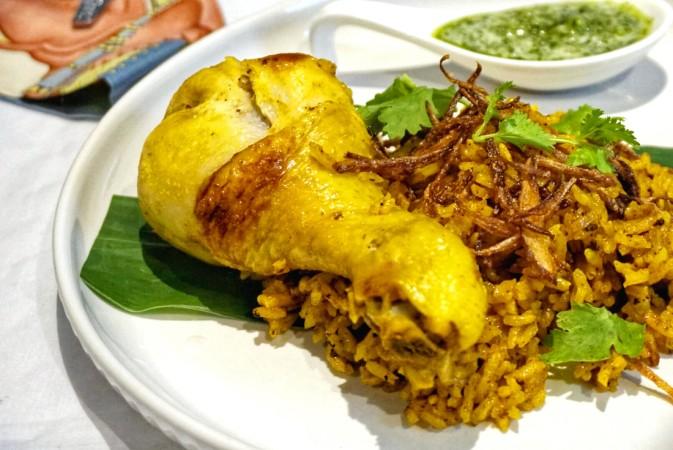
Khao Mok Gai - © Lion Brand Authentic Thai Rice
Festivals & Local Celebrations
Phang Nga's festivals and local celebrations offer a vibrant glimpse into the region's cultural tapestry. These events are deeply rooted in tradition and provide visitors with an opportunity to engage with the local community.
Phang Nga Festival
Held every December, the Phang Nga Festival is a major cultural event that showcases the province's heritage. The festival features traditional dance performances, local music, and a variety of stalls selling regional crafts and foods. Highlights include parades and exhibitions that celebrate Phang Nga’s history and artistic traditions. It's a lively event where locals and visitors come together to enjoy music, dance, and culinary delights.
Songkran Festival (Thai New Year)
Songkran, Thailand's New Year holiday held in April, is famous for its fun water battles. In Phang Nga, the festival combines traditional rituals with fun water splashing. Locals and visitors alike gather on the streets, equipped with water pistols and buckets, to participate in playful water fights. The festival also includes religious ceremonies, such as visiting temples to make merit and pour water over Buddha statues as a symbol of purification and renewal.
Chak Phra Festival
This yearly celebration, celebrated in October, honors the Buddhist practice of "Chak Phra," or the rotation of Buddha's footsteps. The festival features processions with elaborately decorated floats carrying statues of Buddha. These floats parade through the streets, accompanied by traditional music and dance performances. The Chak Phra Festival is an important cultural event that reflects the deep spiritual heritage of Phang Nga.
Ngan Pho Phong Festival
This festival, celebrated in March, honors Phor Phong, a revered local deity. Religious services, local entertainment, and traditional dancing are all featured at the occasion. It's an opportunity for the community to pay respect to their ancestors and seek blessings for the year ahead. The festival is marked by lively celebrations and offers visitors a chance to witness local religious practices and cultural expressions.

Chak Phra Festival - © Thailand NOW
What to Do in Phang Nga
Phang Nga offers a diverse range of activities to suit various interests, from outdoor adventures to cultural explorations. These activities offer a blend of adventure, relaxation, and cultural enrichment, making Phang Nga a versatile destination for all types of travelers.
- Island Hopping: Explore the stunning islands surrounding Phang Nga, such as Koh Phi Phi and Koh Panyee. Each island offers unique landscapes, from pristine beaches to hidden lagoons, making island-hopping an exciting way to experience the region’s natural beauty.
- Kayaking: Paddle through the serene waters of Phang Nga Bay and discover hidden caves and lagoons. Kayaking provides an intimate way to explore the bay’s impressive limestone formations and lush mangrove forests.
- Cave Exploration: Venture into Phang Nga’s intriguing caves, such as Tham Lot and Tham Suwan Khuha. These caves reveal fascinating rock formations and ancient stalactites and stalagmites, providing an adventurous and educational experience.
- Thai Cooking Classes: Learn the art of Thai cooking by joining a local cooking class. This hands-on activity allows you to prepare traditional dishes using fresh ingredients, and you’ll gain valuable culinary skills to take home.
- Beach Relaxation: Spend a day relaxing on Phang Nga’s beautiful beaches, such as Ao Phang Nga National Park’s beaches or the secluded shores of Koh Yao Islands. The calm setting is ideal for relaxing and soaking up the sun.
Shopping in Phang Nga
Phang Nga provides a variety of shopping experiences that cater to different tastes and interests. Shopping in Phang Nga offers a blend of local culture and unique finds, providing visitors with opportunities to bring home a piece of Thailand’s charm.
- Local Markets: Visit local markets like Phang Nga Town Market to explore a range of products, from fresh produce to handmade crafts. These markets offer a genuine glimpse into daily life and the opportunity to pick up unique souvenirs.
- Night Markets: The Phang Nga Night Market is a bustling spot where you can find a mix of street food, local crafts, and clothing. The vibrant atmosphere and diverse offerings make it a great place to experience local culture and shop for keepsakes.
- Craft Shops: For handmade and artisanal products, check out local craft shops in Phang Nga. These shops often feature traditional Thai crafts, such as woven textiles, pottery, and wood carvings, reflecting the region’s artistic heritage.
- Souvenir Stores: There are various souvenir stores throughout Phang Nga where you can buy traditional Thai items like silk scarves, jewelry, and decorative objects. These are excellent presents and souvenirs from your vacation.
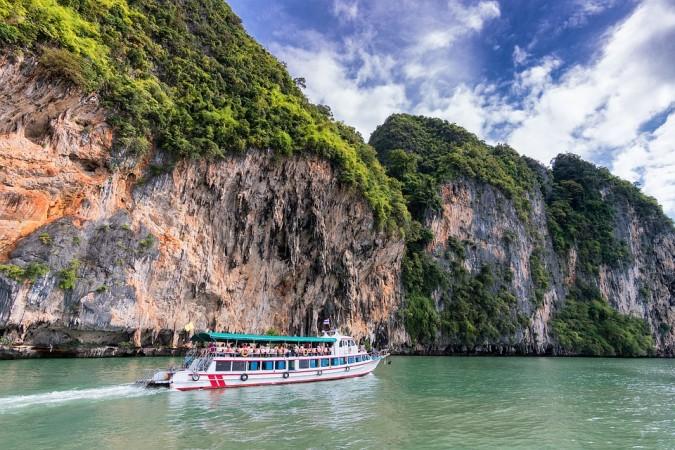
Island Hopping tours around Phang Nga - © qimono
Weather in Phang Nga: Best Time to Visit
Phang Nga has a tropical climate marked by high temperatures and distinct rainy and dry seasons. Understanding weather trends can help you plan your trip to provide the best possible experience.
Dry Season in Phang Nga
This is the peak tourist season in Phang Nga, offering sunny days and minimal rainfall. Temperatures typically range from 25°C to 33°C (77°F to 91°F), making it ideal for outdoor activities like island hopping, kayaking, and beach relaxation. The dry season is perfect for exploring the natural beauty of Phang Nga Bay and the Similan Islands.
Wet Season in Phang Nga
The wet season brings higher humidity and frequent rainfall, with temperatures ranging between 24°C and 32°C (75°F to 90°F). Rain showers are often brief but intense, with occasional heavy downpours. While this period sees fewer tourists, it offers lush landscapes and a quieter atmosphere. It’s a great time for those who enjoy a more serene environment and don’t mind the occasional rain.
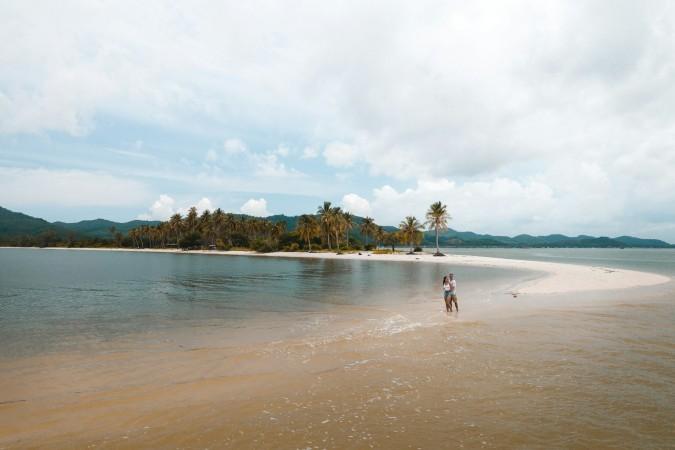
A quite day at Koh Yao Yai, Phang Nga - © Marc Mintel
Essential Travel Information
Getting Around Phang Nga
- Car Rentals: Renting a car is a convenient way to explore Phang Nga at your own pace. Several car rental agencies offer vehicles for hire, allowing you to travel between attractions and enjoy the scenic drive through the province.
- Motorbike Rentals: For a more adventurous option, renting a motorbike is popular among travelers. It provides flexibility and is ideal for navigating smaller roads and exploring remote areas.
- Taxis and Tuk-Tuks: Taxis and tuk-tuks are readily available in Phang Nga Town and surrounding areas. They offer a hassle-free way to get around, though it’s advisable to agree on a fare before starting your journey.
- Local Buses: Public buses connect Phang Nga with major cities and nearby regions. They are an economical choice for longer distances, though schedules and routes may vary.
- Boat Services: To explore islands and coastal areas, boat services are essential. Local operators offer boat tours and transfers to popular islands like Koh Yao and Phang Nga Bay.
ATM & Banking Services
In Phang Nga, accessing banking services and ATMs is convenient, with numerous options available throughout the region. ATMs can be found in major towns and tourist areas, allowing for easy cash withdrawals using international credit and debit cards. Banks offer a range of financial services, including currency exchange and cash withdrawals. Credit cards are widely accepted in most hotels, restaurants, and larger shops, but it’s a good idea to carry some cash for smaller establishments that may not accept cards.
Where to Stay in Phang Nga
- Luxury Resorts: For a lavish experience, Phang Nga features high-end resorts that provide stunning views, upscale amenities, and exceptional service. These resorts offer a combination of luxurious comfort, fine dining, and top-notch facilities, making them ideal for those seeking a premium stay.
- Mid-Range Hotels: Numerous mid-range hotels are available, offering a balance of comfort and value. These hotels provide well-appointed rooms and convenient amenities at a reasonable price, making them a popular choice for travelers looking for quality accommodation without breaking the bank.
- Beachfront Bungalows: For a unique and serene experience, consider staying in beachfront bungalows or villas. These accommodations provide direct access to the beach and a tranquil environment, perfect for those who want to relax and enjoy the natural beauty of Phang Nga.
- Homestays: For a more authentic experience, homestays offer the chance to live with local families. These accommodations provide a unique opportunity to experience daily life in Phang Nga, enjoy home-cooked meals, and gain deeper insights into local customs and traditions.
Articles for you

Explore Yala National Park - Sri Lanka Travel, Asia
Tucked away in Sri Lanka’s southeastern corner, Yala National Park is where wild nature meets deep tradition. Known worldwide for its leopard population, the park is also home to elephants, sloth bears, crocodiles, and hundreds of bird species. Beyond wildlife, Yala opens doors to a cultural landscape dotted with ancient temples, Buddhist ruins, and coastal villages. For travelers seeking more than just a safari, Yala offers a chance to explore eco-tourism, local communities, and sacred heritage sites.
Population: The Yala National Park area doesn’t have a human population.
Economy: The economy around Yala National Park thrives on a blend of eco-tourism, agriculture, and local services. Safari tours, eco-lodges, and cultural experiences drive steady income for nearby towns like Tissamaharama and Kataragama, supporting thousands of families.
Landmarks: Famous for Block I of Yala and wildlife encounters, including elephants, sloth bears, crocodiles, and exotic bird species.

Explore Galle - Sri Lanka Travel, Asia
Nestled on Sri Lanka’s southern coastline, Galle is a vibrant city where history meets the sea. Its cobbled streets, colonial architecture, and serene beaches make it a must-visit destination for travelers seeking a blend of culture, adventure, and relaxation. A UNESCO World Heritage site, Galle captivates visitors with its Dutch Fort, bustling markets, and friendly locals. Whether you’re exploring the ramparts at sunset or savoring fresh seafood by the shore, Galle promises an unforgettable journey into Sri Lanka’s heritage.
Population: Approximately 113,000 in 2023.
Economy: Galle’s economy thrives on tourism, trade, and fisheries. The city’s historic fort, colonial architecture, and coastal charm draw thousands of international visitors each year, making tourism its main economic driver. Fishing remains vital for local livelihoods, supplying fresh seafood across the region.
Landmarks: Famous for the Galle Fort, Dutch Reformed Church & Maritime Museum, and Unawatuna Beach.

Explore Bentota - Sri Lanka Travel, Asia
Nestled along Sri Lanka’s southwestern coast, Bentota is a tropical paradise that blends golden beaches, vibrant culture, and thrilling adventures. Famous for its calm waters, luxury resorts, and scenic river estuary, Bentota has become a top destination for travelers seeking both relaxation and authentic experiences. From serene beach walks at sunrise to adrenaline-pumping water sports, this coastal town offers a perfect balance of leisure and exploration. With its proximity to Colombo and Galle, Bentota is easy to reach, making it an ideal stop for both short escapes and extended holidays.
Population: Approximately 37,000 in 2023.
Economy: Bentota’s economy thrives mainly on tourism, which drives local businesses such as hotels, restaurants, and wellness retreats. The town also benefits from fishing, coconut cultivation, and handicrafts like wood carving and batik textiles. Many residents rely on the growing demand for water sports and Ayurvedic treatments, making tourism the backbone of both income and employment in the area.
Landmarks: Famous for Bentota Beach, Bentota River Safari, and Kande Vihara Temple.

Explore Mirissa - Sri Lanka Travel, Asia
Mirissa is a charming coastal town on Sri Lanka’s southern shoreline. Known for its golden beaches, turquoise waters, and vibrant marine life, it has become a must-visit stop for travelers exploring the island. Many come for whale watching, surfing, and sunset views at Coconut Tree Hill, but Mirissa offers much more than postcard beauty. The fishing boats you see anchored by the bay carry generations of stories. Local traditions, delicious cuisine, and a laid-back rhythm of life shape every visitor’s experience.
Population: Approximately 4,700 in 2023.
Economy: Mirissa’s economy is largely shaped by its coastal location. Fishing has long been the backbone of local livelihoods, with generations relying on the Indian Ocean for income. In recent decades, tourism has become the main driver of growth, thanks to whale watching, surfing, and beachside hospitality.
Landmarks: Famous for Mirissa Beach, Coconut Tree Hill, and Parrot Rock Bridge.

Explore Nuwara Eliya - Sri Lanka Travel, Asia
Tucked away in the Central Highlands of Sri Lanka, Nuwara Eliya is often called “Little England”. With its rolling tea plantations, cool misty mornings, and colonial charm, this mountain town feels like a step into another world. Travelers come here to breathe fresh air, walk through flower gardens, sip the finest Ceylon Tea, and enjoy a pace of life far from the island’s busy cities. Whether you’re drawn by scenic landscapes, heritage architecture, or the warmth of its people, Nuwara Eliya is a destination that blends nature, culture, and history in perfect harmony.
Population: Approximately 781,000 in 2023.
Economy: Nuwara Eliya’s economy thrives mainly on tea production, as it sits in the heart of Sri Lanka’s central highlands, famous worldwide for Ceylon Tea. The city also benefits from a growing tourism industry, attracting visitors with its colonial charm, cool climate, and scenic landscapes.
Landmarks: Famous for Gregory Lake, Hakgala Botanical Garden, and Victoria Park.

Explore Sukau - Malaysia Travel, Asia
Nestled on the banks of the Kinabatangan River in Sabah, Malaysian Borneo, Sukau is a destination where wildlife, culture, and conservation come together. Known as one of Asia’s top spots for river safaris and eco-tourism, this quiet village offers a front-row seat to encounters with Bornean orangutans, pygmy elephants, proboscis monkeys, and exotic birdlife.
Population: Approximately 1,400 in 2019.
Economy: Sukau’s economy is shaped by its riverine location and natural resources. Traditionally, the Orang Sungai community relied on fishing, small-scale farming, and forest gathering for their livelihood. Today, the village has shifted toward eco-tourism, with river cruises, jungle trekking, and homestays providing income.
Landmarks: Famous for the Kinabatangan River cruises, Gomantong Caves, and Ox-bow lakes and wetlands.
